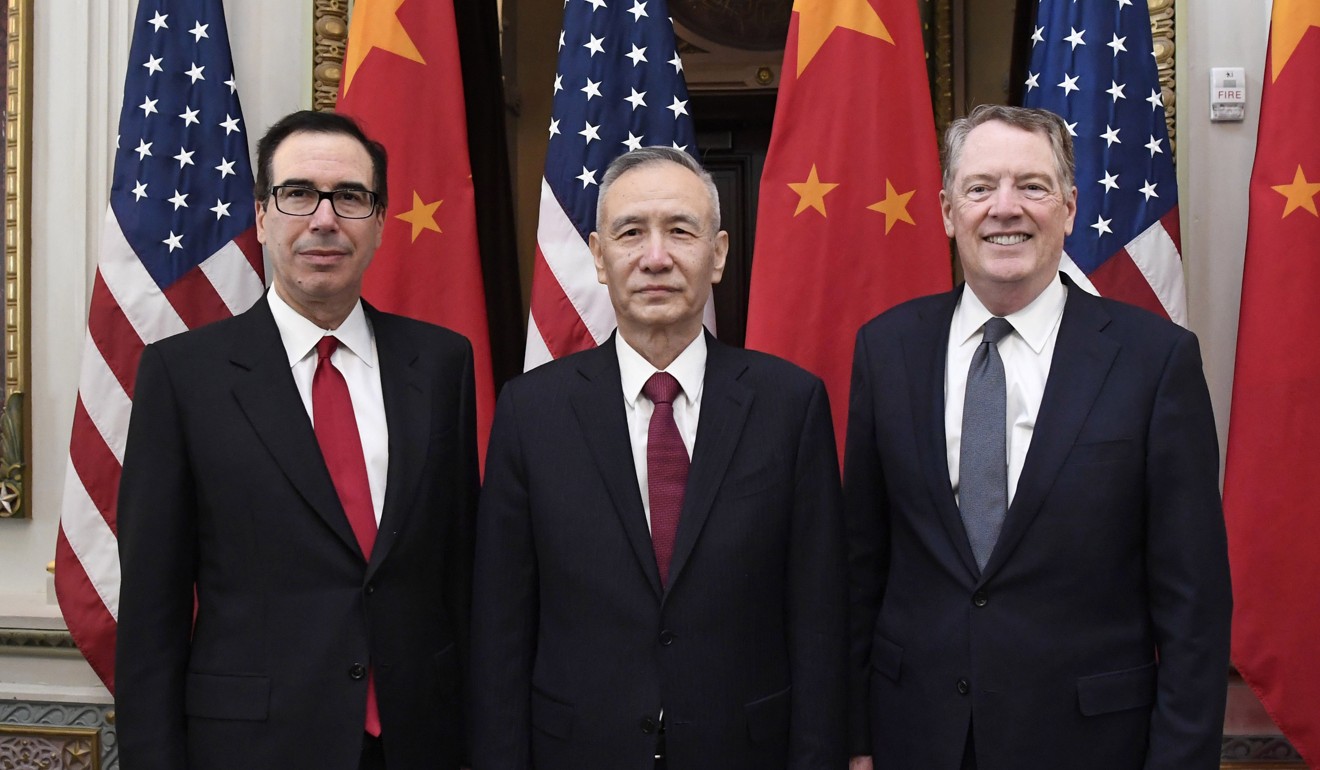
New round of US-China trade talks begins in Washington with eye toward reaching framework for final deal
- Beijing is expected to announce a large purchase of US agricultural and energy products, which will be incorporated into the overall agreement
- Key structural issues yet to be resolved include forced technology transfers, cybertheft and market access
China and the United States began a fresh round of high-level talks in Washington on Thursday, amid reports of progress in their bid to nail down a meaningful deal ahead of the deadline for an agreement to end their trade war.
Time is running short toward March 1 when the US has threatened to raise tariffs on US$200 billion of Chinese products from 10 per cent to 25 per cent.
On Tuesday, however, US President Donald Trump suggested that he might extend the March 1 deadline, saying the talks were going “very well” and “the date is not a magical date”.
Working-level negotiations began on Tuesday, with cabinet and ministry officials joining the talks for two days beginning on Thursday. The previous round of negotiations took place last week in Beijing.
In Washington, the two sides are expected to outline a memorandum of understanding on challenging structural issues including forced technology transfers, cybertheft, market access and currency. China is also expected to announce a large purchase of US agricultural and energy products, which will be incorporated into the memorandum.
Beijing will propose buying an additional US$30 billion annually of American farm products such as soybeans, corn and wheat, Bloomberg reported on Thursday. The US will also demand that China maintain a stable value of its currency, the yuan, Bloomberg said.
US Secretary of State Mike Pompeo said in an interview with Fox Business on Thursday that the US was pushing hard on thorny issues in addition to reducing the bilateral trade imbalance.
The real progress is “not just on the trade issues, but on intellectual property protection, forced technology transfer and, more importantly, enforcement around those”, he said.
“It’s one thing to write something on a piece of paper; it’s another thing to have enforcement mechanisms,” Pompeo added.
US Trade Representative Robert Lighthizer, who leads the American negotiating team, has been asked to appear before the House Ways and Means Committee on Wednesday to testify on China-US trade issues. The committee is now controlled by Democrats, who became the majority party in the US House of Representatives last month and have promised more stringent oversight of the Republican administration.
A memorandum of understanding would be the most significant movement yet in the trade war that the US started in July. It is expected to lay the groundwork for a final resolution to the deep-rooted disputes and culminate in a face-to-face meeting between Trump and Chinese President Xi Jinping.
“We’ve heard good news coming out in terms of progress being made,” Elizabeth Economy, director of Asia studies at the Council on Foreign Relations, said on Tuesday.
“There’s going to be two baskets of issues. The ones that are easy, like trying to make progress on the bilateral trade deficit, maybe some market opening and coerced technology transfer, where they’ve already taken some steps. And then there’s the tougher issues like ‘Made in China 2025’ and their subsidies and enforcement issues.
“My hope would be that we end up with some actual substantive agreement on the first basket and some kind of road map to continued discussions and progress moving forward on the second basket.”
Other observers also are expecting the talks to continue after this week’s meetings in Washington.

“We think this round of talks is unlikely to be the last round, given the scepticism, and with both sides miles apart – an extension of the truce appears to be the most likely outcome,” Prakash Sakpal, Asia economist at ING in Singapore, said in a research note.
“For now, markets should take comfort in the fact that both sides are aiming for a deal, have started to outline it, and are working out agreements on the stickier issues,” he said. “Nothing concrete yet, and we may not see anything until the next Trump-Xi meeting later in March.”
The Chinese delegation is led by Vice-Premier Liu He and includes Yi Gang, governor of the People’s Bank of China; Wang Shouwen, vice-minister of commerce; and Liao Min, vice-minister of finance.
Liu carries an additional title: special envoy for Xi. It marks the second time he has come to the US as special envoy for trade talks. The last he carried the special envoy title was in May 2018.
On the US side, the talks are chaired by Lighthizer and Treasury Secretary Steven Mnuchin.
Unlike the meeting two weeks ago in Washington, there was no small talk between the two sides before the start of negotiations on Thursday morning.
Additional reporting by Robert Delaney

